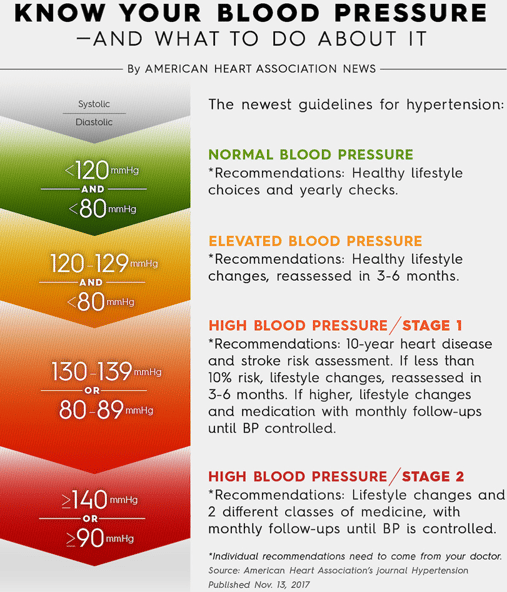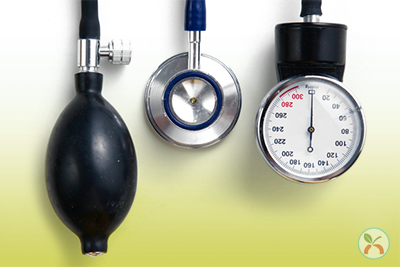Can you hear that? Well, you could if you had a sphygmomanometer and a stethoscope. It’s the sound of blood pressure going up.
Based on new blood pressure guidelines set up by the American Heart Association and the American College of Cardiology, about 1 in 2 adults in the United States now have elevated blood pressure.
But there’s more to the new guidelines than just looking for different numbers for systolic and diastolic blood pressure. Recommendations for treating high blood pressure have changed too.
And there’s ONE recommendation for treating high blood pressure that you’ll find at every stage from normal to a hypertensive crisis: lifestyle medicine.
In case you missed it, here’s the short version of the new guidelines:
- Normal: Less than 120/80 mm Hg.
- Elevated: Systolic between 120-129 and diastolic less than 80.
- Stage 1: Systolic between 130-139 or diastolic between 80-89.
- Stage 2: Systolic at least 140 or diastolic at least 90 mm Hg.
- Hypertensive crisis: Systolic over 180 and/or diastolic over 120, with patients needing prompt changes in medication if there are no other indications of problems, or immediate hospitalization if there are signs of organ damage.
Why tighten the standards for blood pressure?
Think of it like this. If you turned on the garden hose in your backyard and let it run for days, weeks, maybe even years, your water bill would grow exponentially.
And there’d be other problems too, like flooding your yard, killing plants, creating pools of standing water that breed mosquitoes and bacteria, and property damage.
You wouldn’t sit back and do nothing. Right?
Rising blood pressure has created a flood of health problems. And a panel of 21 scientists and health experts decided it was time to take action.
Some of the reasons for updating blood pressure standards include:
- It’s been 15 years since blood pressure guidelines have been updated. And in that time, more and more people have developed high blood pressure and associated health problems.
- 7 of the 15 most prevalent causes of death in the U.S. are linked directly to high blood pressure, according to a report published by the U.S. Department of Health and Human Services.
- In 2011, high blood pressure in the United States cost an estimated $46 billion in health care services, medications, and missed days of work, according to a report published in Circulation.
- And lifestyle factors that impact blood pressure like diet and exercise continue to fall short of minimum recommendations.
Use lifestyle medicine to improve workforce health
The new guidelines provide a way to detect, prevent, manage, and treat high blood pressure. And one key recommendation for blood pressure is the same at every stage…Healthy Lifestyle Habits.
Here’s a quick look at what’s recommended to treat blood pressure based on the new guidelines:
Normal: Treatment or Follow-up
- Maintain Healthy Lifestyle Habits.
- Follow a mostly plant-based diet.
- Be as physically active as possible.
Elevated: Treatment or Follow-up
- Medication is not recommended.
- Adopt Healthy Lifestyle Habits.
- Follow the DASH Diet.
- Increase physical activity.
Stage 1: Treatment or Follow-up
- Medication may be necessary.
- Adopt Healthy Lifestyle Habits.
- Follow Elevated treatment recommendations.
- If risk is less than 10%, reassess blood pressure after 3 to 6 months.
Stage 2: Treatment or Follow-up
- Medication is necessary.
- Adopt Healthy Lifestyle Habits.
- Follow Elevated treatment recommendations.
- Reassess blood pressure monthly, until risk is less than 10% (Stage 1).
Hypertensive Crisis: Treatment or Follow-up
- Medication is necessary.
- Consider hospitalization.
- Adopt Healthy Lifestyle Habits.
- Follow Elevated treatment recommendations.
- Continuous monitoring of blood pressure may be necessary.
Is high blood pressure a problem in your population?
It probably is. And if you leave the hose running, it’s not going to get any better.
Fortunately, you can change that, and many other population health risk factors with the right approach.
How do you motivate and encourage people to adopt Healthy Lifestyle Habits?
Check out this webinar about the new blood pressure guidelines and Readiness to Change.









